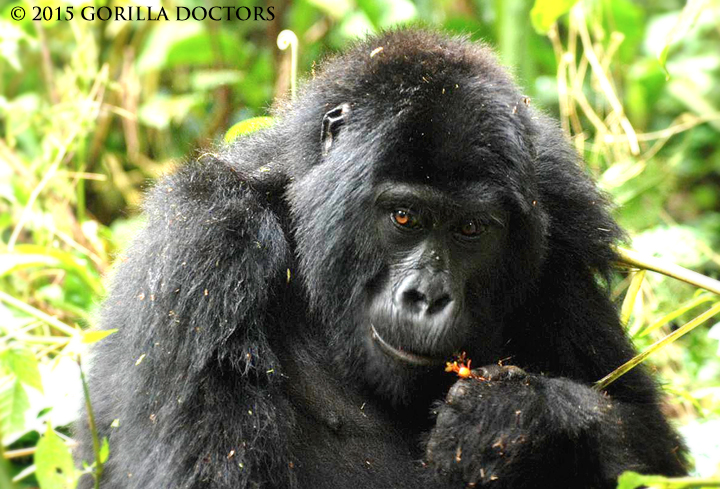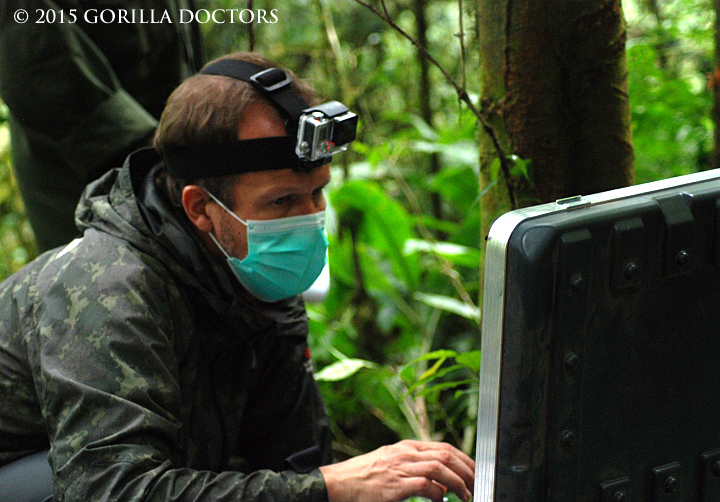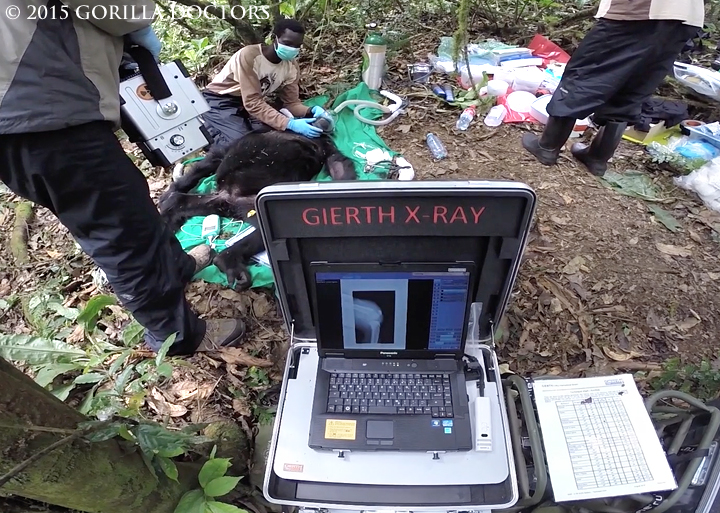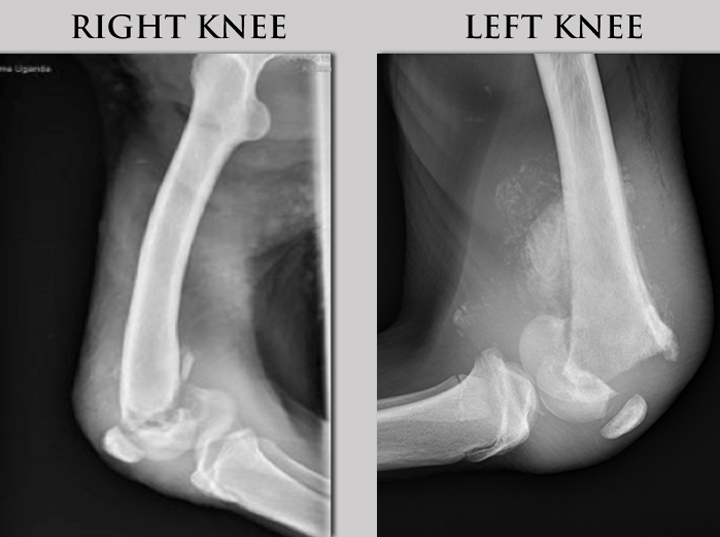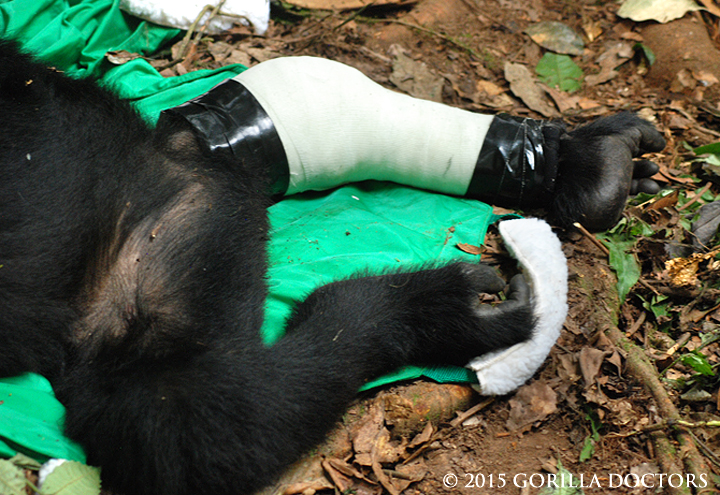A Trio of Interventions to Attempt to Save Severely Injured Unhabituated Female
By Gorilla Doctors Staff on Thursday, September 10th, 2015 in Blog.Our field veterinarians have had their hands full in the last few weeks with unusual and complicated cases. As always, the vets put 100% of their energy and available resources into saving a life. Sadly, these interventions are not always successful, as was the case of an injured unidentified female mountain gorilla in Bwindi Impenetrable National Park.
Uganda Wildlife Authority rangers observed the unhabituated gorilla trailing Mubare group in Bwindi on August 19th. The rangers reported that the female was having great difficulty moving and appeared to have some kind of wound on her hip. UWA contacted Dr. Fred, Gorilla Doctors Uganda Field Vet, who traveled to Buhoma for a veterinary assessment, prepared to intervene and treat the gorilla if necessary.
When Dr. Fred found the female in the forest, he confirmed that she was not bearing weight on her legs and had a wound on her right hip. Our Uganda Field Vet administered antibiotics via a dart and notified our Regional Manager, Dr. Joost Philippa, who crossed the border from Rwanda to Uganda with a newly acquired portable X Ray machine.
Drs. Joost, Fred and Ricky did a full immobilization during this second intervention, giving the female fluids and taking x rays of both her hips and left knee. The x rays revealed a severe fracture in the female’s left distal femur. The wound on her right hip appeared to be a type of bedsore that developed from laying on her right side for an extended period of time. This was an unusual case as this female appeared to be an older animal (20 years or more), however, her bones looked like that of an adolescent’s: the growth plates were not closed.
“The x ray machine was really a timely acquisition for this case” said Dr. Mike. The left knee was so badly damaged, it was very easy to see that the leg was broken, even without an x ray. However, Dr. Mike palpated the right leg during the intervention and couldn’t get the leg to extend properly, but he said he didn’t think it was broken until they took the x ray.
Radiologist Dr. Donna Magid of Johns Hopkins University School of Medicine worked with our team to assess the fracture and provided valuable insight to our field vets from her office in Baltimore, Maryland. Dr. Mike, who has worked with the Radiologist from his early days at the Baltimore Zoo, sent the x rays to Dr. Magid from Uganda via email for consultation.
“The fractures in each leg were similar in every way except their apparent age” said Dr. Magid. “The first appeared to be a month to six weeks old, while the right leg was a much newer injury. This was an injury that a human wouldn’t have been able to tolerate. It was clear looking at the x rays that the animal had been trying to use the injured leg for a long time.”
“This type of injury acts like a parasite on the animal… it usurps the resources and becomes the focus of the whole factory” added Dr. Magid. “Gorillas are incredibly resilient animals, but they have a natural tendency to obscure outward signs of injury or illness for their own protection. This young female was likely close to death when the field team found her. The prognosis was grave.”
After consulting with Dr. Magid, Gorilla Doctors prepared for a third intervention, to fit the severely broken leg with a fiberglass cast. On Friday, August 28th, Bwindi’s Assistant Warden for Tourism, Mr. Sunday Charles Ndayakunze, accompanied the intervention team, comprised of Gorilla Doctors Director Dr. Mike Cranfield, Regional Manager Dr. Joost Philippa and Uganda Field Vets Drs. Fred Nizeyimana and Ricky Okwir Okello, into the forest.
During this intervention, the team decided to cast the more damaged left leg with a fiberglass cast, because a gypsum (plaster of Paris) cast would not hold up in the forest conditions. When the gorilla awoke from the anesthesia, she examined the cast and played with it a bit. She had trouble mobilizing, so rolled around initially to feed on vegetation.
This is the first time that a broken bone in a wild gorilla has ever been casted. Recently, another patient of Gorilla Doctors, orphan Grauer’s gorilla Kalonge, fractured her femur when she fell from a tree at the Senkwekwe Center. With lack of supplies (the x ray had not arrived yet) and an unsterile environment, the treatment was limited. However, the young female healed extremely well in just 8 weeks. Read more about Kalonge’s fractured femur here.
The Gorilla Doctors treat all wild gorillas in the forest – a gorilla is never removed from the forest, until it has passed away, at which point it will be carried down the mountain to our laboratory for a post-mortem examination. Unfortunately, it is impossible to create a sterile environment in the forest. In orthopedic surgery, sterility is vital, therefore surgery was ruled out as a viable treatment option.
The following morning, Drs. Mike, Joost, Fred and Ricky trekked back into Bwindi to see how the patient was faring with her new cast, but unfortunately, found her in very poor condition. She was hypothermic, with no pupillary reaction, and very close to death. Since mountain gorillas are a highly endangered animal, there is no policy for euthanasia in Uganda, but the injured female died naturally shortly after the team arrived.
The subsequent necropsy revealed a few incidental findings such as a heavy intestinal parasite load, though nothing significant. There was no cancer or metabolic issue at play here, according to the post-mortem results.
When asked to speculate on the gorilla’s cause of injury, Dr. Mike thought a fall may have been to blame for the older fracture in the left leg, causing the animal to put more pressure on the right leg, leading to the newer fracture. There were no bite wounds, or any other indication of gorilla-inflicted trauma. “We did our best and were pushing the envelope with this case” said Dr. Mike. Sadly, this gorilla did not survive her extensive injuries.
Watch Go Pro footage from the intervention below:


 Donate
Donate
